Acciona Gets Federal Grant to Expand
February 18, 2010 - The Spanish company Acciona will be expanding its Boulder City, Nevada, parabolic trough solar thermal plant as the Department of Energy awarded it a $2.9 million grant.
The grant for Acciona comes in lieu of the tax credit the company would have gotten for expanding its plant. The grants allow developers to recoup 30 percent of the cost of construction.
When it was completed in 2007 Nevada Solar One was the first solar power plant built in 17 years. It sparked interest in large-scale renewable energy development across the country.
Acciona in September adding 40 solar troughs and increasing the electric output slightly.
Article in Las Vegas Sun >>here.
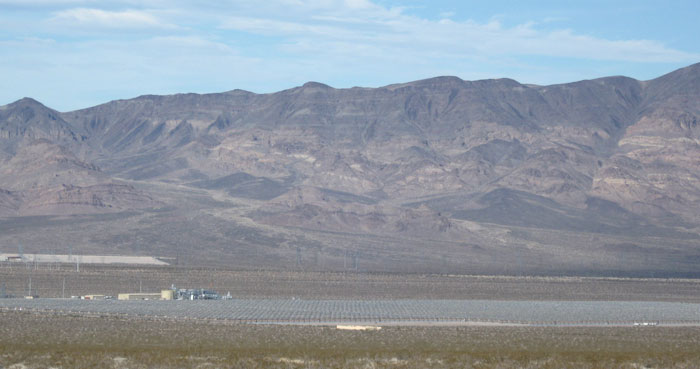
Opened for commercial operation in 2007, Solar 1 puts out a modest 50-64 megawatts (MW). Thirty miles away, Hoover Dam generates 2,074 MW of hydroelectric power from the Colorado River. Large coal-burning and nuclear power plants generate typically 1,000 MW, 24 hours a day. So far the energy produced cannot be stored for long periods and thus the plant does not produce energy during the night or on cloudy days. Right now, Solar 1 is basically piggy-backing on Hoover Dam hydroelectric power, as well as a natural gas fired power plant across the street.
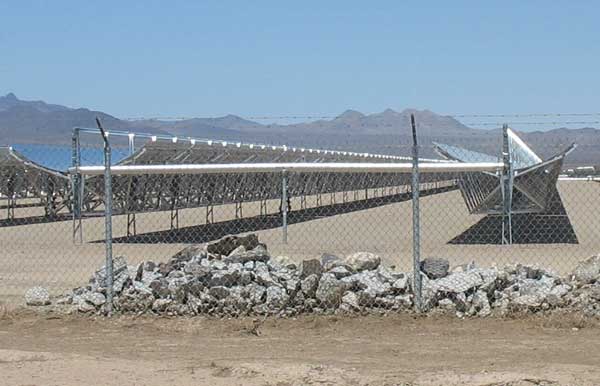
<The parabolic mirrors pointed upward towards the mid-day sun, concentrating the solar radiation onto central tubes to heat fluids.
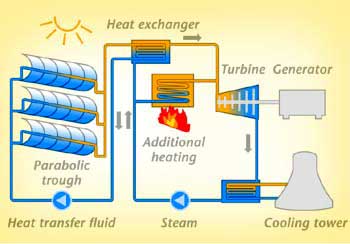
Solar 1 Nevada cost $266 million to build. It has 19,300 PTR-70 receivers from Germany and Israel, the vaccuum tubes filled with heat transfer fluid that heat when the mirror troughs reflect sunlight on them. The mirrors turn to track the sun. The 760 parabolic troughs have more than 180,000 mirrors, made in Germany. The tube fluid is heated to 735 °F (391 °C), and this heat is then exchanged to water in pipes to produce steam which drives a conventional turbine. The power block is a 70-MW reheat steam turbine engine made in Sweden. The solar power plant is not 100% renewable, but has a 2% fossil fuel back-up from a small natural gas heater, used to prevent the water from freezing, and to continue generation during cloudy days and peak demand periods. Nevada state law does not allow more than 2% fossil-fuel back-up, so this plant uses much less than other Mojave Desert CSP plants in the Mojave Desert of California and Arizona. Operation and maintenance (and profits) are by the Spanish company Acciona Energia. The energy will be sold to Nevada Power Company and Sierra Pacific Power Company.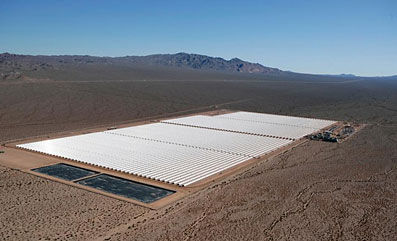
Solar 1 Nevada takes up 400 acres (200 football fields) of desert, or 1.62 square kilometers. The land is leased from Boulder City (Clark County, Nevada; population 15,000) in its 3,000 acre "green energy zone" outside of the city in El Dorado Valley (an area of lush creosote desert and small playas). The plant has been reported to produce electricity at 15-17 cents/kilowatt-hour (kWh). Coal costs 3 to 6 cents/kWh. Transmission lines were already in place, lowering that cost, as Solar 1 was built across the road from the existing 480 MW El Dorado Energy combined cycle gas power plant owned by Sempra. The Nevada Commission on Economic Development secured financing and tax incentives of about $10-15 million to help the company build the plant. During the 16 month construction period, 1.5 million working hours were put in by a workforce that averaged 400 and peaked at 850. There are 28 permament jobs.
Acciona Energy in 2007 closed $266 million in long-term financing for Nevada Solar One. The leveraged lease was financed by debt participants Banco Santander and BBVA, headquartered in Spain, and Portugal's CAIXA Geral de Depositos. Santander, BBVA and CAIXA are the Mandated Lead Arrangers for the debt financing of the construction and term loan. The lease was also funded by equity investors JPMorgan Capital, Northern Trust and Wells Fargo. Capstar Partners and JP Morgan Capital co-led the equity syndication. (Source: Cleantech.com)
"Green-scabbing"
But union leaders complained that Nevada Solar One hired workers from Central America and not Nevada, as it had promised.
Acciona got a $15 million tax rebate from the Nevada Commission on Economic Development to hire locally and pay the state's prevailing wage, but instead used workers from Mexico and El Salvador for "a fraction of the cost," Rich Johnson, president of the Southern Nevada Building and construction Trades Council, said.
Boulder City Councilwoman Linda Strickland said if the city required in its contract that the companies use in-state labor, it would be difficult to enforce the provision. (From the Las Vegas Sun.)
Water-Thirsty Electricity
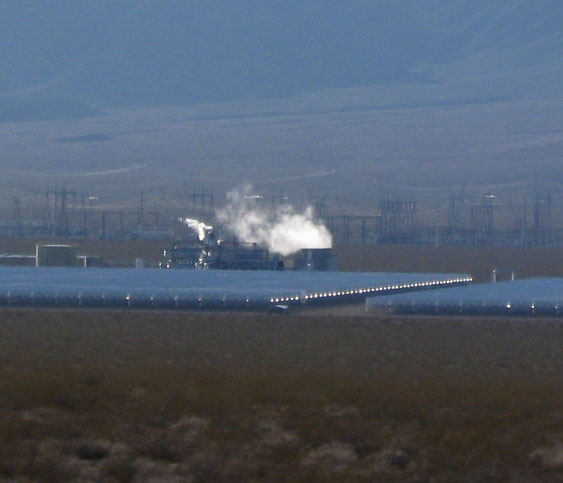
>The cooling towers at Nevada 1 Solar evaporated huge amounts of water from the Colorado River to cool the steam cycle.
This "wet-cooled" solar thermal plant uses 400 acre-feet of water per year, about 6 acre-feet of water per MW. To put it another way, coal fired power plants use 110 to 300 gallons per megawatt hour; a nuclear plant uses between 500 and 1100 gallons/MWh; and a solar parabolic trough plant uses 760 to 920 gallons/MWh. Solar thermal power plants, like coal, natural gas, and nuclear plants, boil water into superheated steam, which then turns turbines to generate electricity. The steam must be condensed back into water in cooling towers, and this is where most of the fresh water is used up in wet-cooled systems. Waste heat is dissipated in steam evaporated off into the air. For Nevada 1, the water comes from Lake Mead through negotiation with Boulder City's supply. The Colorado River is already strained in allocations for multiple states and cities.
The Sierra Club says it will try to push for dry-cooled, "air-cooled" solar thermal plants in the California deserts, which however, are less efficient. In an attempt to save water, these kinds of solar thermal power plants use dry desert air instead of water to cool the operation. But this greatly increase building costs because enormous cooling towers need to be constructed. Also relying on air to cool would not cool the water circulating through the plant to a low enough temperature for peak performance, decreasing the efficiency of the plant.
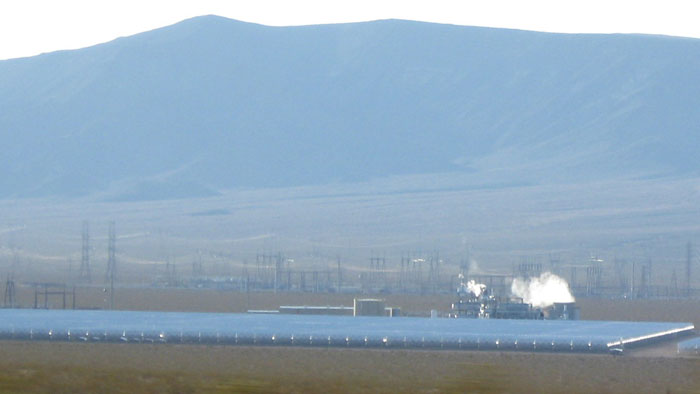
The Bureau of Land Management has received 130 applications for large-scale photovoltaic and concentrated-solar projects on 1 million acres of land in the West. In response to the concerns over water shortages and habitat destruction BLM decided to take a cautious route when approving applications for solar projects, announcing it would accept no other applications for large-scale solar projects on its western lands pending the completion of an Environmental Impact Statement.
The delay raised the ire of Senator Harry Reid (D-NV) and the solar industry, so BLM reversed its decision, and will continue accepting applications for industrial-scale projects with no plan for how to allow such drastic water consumption.
Power is then stepped up by a transformer and distributed to the grid at 230 kV from the huge switchyard.
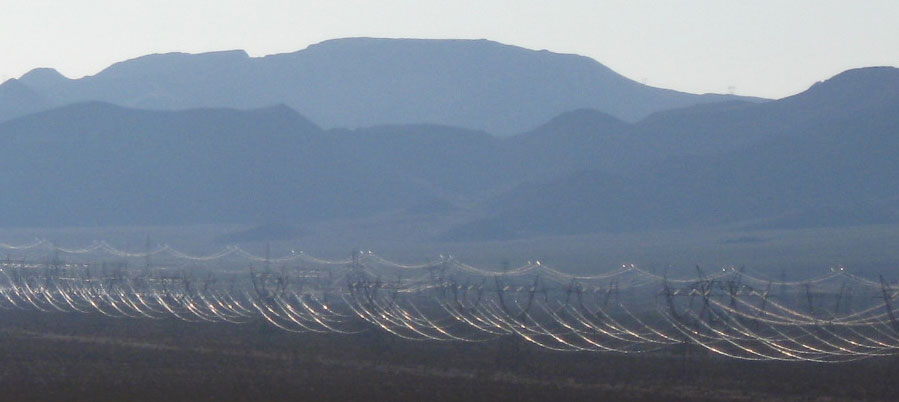
(Photovoltaic systems installed on roofs convert sunlight directly to electricity using the semiconductor materials in solar panels, with no water needed, and no expensive transmission lines.)
March 8, 2009 - See the artcile in the Las Vegas Sun about Boulder City's plans for more solar plants here >>here.
HOME.....Solar in the Desert.....New Photovoltaic Plant......The Problem.....The Solution
